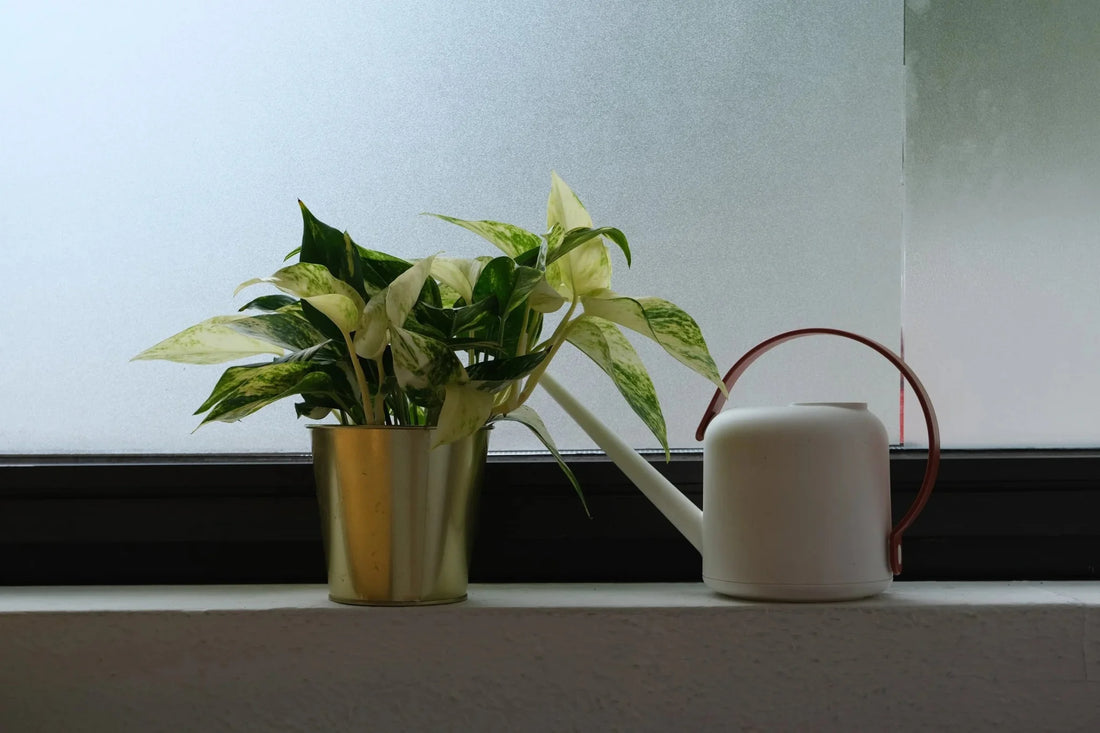Watering

Let’s talk about watering. The right watering schedule can mean life or death for your plants. And I’m here to tell you that a watering ‘schedule’ is not always the best idea. Lots of different aspects can affect when your plant needs water. Most likely, your Monstera doesn’t need to be watered every 5 days like clockwork. Don’t worry, we’re here to break it down for you.
Sunlight. Pot size. Root size. Type of plant. Soil type. All of these things will change how often your houseplant needs to be watered.
How does sunlight affect my plant’s watering needs? Depending on the time of year, your plant will receive more or less sunlight which in turn will affect how quickly your plant dries out. You may have noticed that your plant needs more water in the summer than it does in the winter. Where you place your plant in relation to the direction of the sun and distance from a window will also play a little part in this, but we’ll save plant placement for another post.
What size pot do you have your plant in relative to the size of it’s root system? If your plant has a small root system and you place it in a large pot, your plant will not be able to drink up all the water in the soil and it will be more prone to root rot. Plants don’t like to sit in soggy soil! Most plants like to be slightly rootbound, which means the roots are snug and cozy in the pot.
Every plant has different needs, just like us. Some like to be kept in moist soil, some do best to dry out between waterings. These things are important to know before you can assess when your plant will need a drink. Calatheas love high humidity or their leaves will get crispy, cacti can go longer periods without being watered. Get to know your plant. This may take a little research but we will cover specific care for different types plants in later posts!
All soils are not created equally. If you’ve been using ‘all purpose potting soil’ for every plant, listen up! The contents of your soil will determine how quickly your plant can dry out. If your plant needs to be on the dryer side, use a well draining soil mix with ingredients like sand, small rocks, coco coir, perlite, pumice, or vermiculite. These ingredients help to aerate soil, provide drainage, and slowly release water so your plant isn’t living in a swamp. If your plant doesn’t like to dry out so quickly, coco coir, peat moss and compost are all great for retaining water. We will cover some more in depth information on soil types later.
So how can we prevent overwatering and underwatering? Here are some best practices for your houseplant to keep it alive and thriving:
Keep your plant in a nursery pot that you can pull out and check or keep your plant in a pot that has a drainage hole. If excess water can’t drain out from your pot, you won’t have a happy environment for your plant to live in. If your plant lives in a nursery pot, you can still give it a pretty home by placing the nursery pot into a decorative pot. In this instance, it is not necessary for this decorative pot to have a drainage hole. Personally, I like to keep all of my plants in nursery pots. When I am doing a plant check, I will pull the nursery pot out of the decorative pot. This allows me to see the soil at the bottom of the nursery pot and I can see if it looks dry or wet. You can also feel the weight of the pot. It will be much heavier when just watered, and lighter if the soil is dry.
Another thing you can do is buy a moisture meter or just use the good ole’ finger test. If you stick your finger a few inches down into the soil, you can feel if the soil there is still wet or not.
I hope this little bit of information will help you in your plant journey! Stay tuned for many more plant care tips!
Sunlight. Pot size. Root size. Type of plant. Soil type. All of these things will change how often your houseplant needs to be watered.
How does sunlight affect my plant’s watering needs? Depending on the time of year, your plant will receive more or less sunlight which in turn will affect how quickly your plant dries out. You may have noticed that your plant needs more water in the summer than it does in the winter. Where you place your plant in relation to the direction of the sun and distance from a window will also play a little part in this, but we’ll save plant placement for another post.
What size pot do you have your plant in relative to the size of it’s root system? If your plant has a small root system and you place it in a large pot, your plant will not be able to drink up all the water in the soil and it will be more prone to root rot. Plants don’t like to sit in soggy soil! Most plants like to be slightly rootbound, which means the roots are snug and cozy in the pot.
Every plant has different needs, just like us. Some like to be kept in moist soil, some do best to dry out between waterings. These things are important to know before you can assess when your plant will need a drink. Calatheas love high humidity or their leaves will get crispy, cacti can go longer periods without being watered. Get to know your plant. This may take a little research but we will cover specific care for different types plants in later posts!
All soils are not created equally. If you’ve been using ‘all purpose potting soil’ for every plant, listen up! The contents of your soil will determine how quickly your plant can dry out. If your plant needs to be on the dryer side, use a well draining soil mix with ingredients like sand, small rocks, coco coir, perlite, pumice, or vermiculite. These ingredients help to aerate soil, provide drainage, and slowly release water so your plant isn’t living in a swamp. If your plant doesn’t like to dry out so quickly, coco coir, peat moss and compost are all great for retaining water. We will cover some more in depth information on soil types later.
So how can we prevent overwatering and underwatering? Here are some best practices for your houseplant to keep it alive and thriving:
Keep your plant in a nursery pot that you can pull out and check or keep your plant in a pot that has a drainage hole. If excess water can’t drain out from your pot, you won’t have a happy environment for your plant to live in. If your plant lives in a nursery pot, you can still give it a pretty home by placing the nursery pot into a decorative pot. In this instance, it is not necessary for this decorative pot to have a drainage hole. Personally, I like to keep all of my plants in nursery pots. When I am doing a plant check, I will pull the nursery pot out of the decorative pot. This allows me to see the soil at the bottom of the nursery pot and I can see if it looks dry or wet. You can also feel the weight of the pot. It will be much heavier when just watered, and lighter if the soil is dry.
Another thing you can do is buy a moisture meter or just use the good ole’ finger test. If you stick your finger a few inches down into the soil, you can feel if the soil there is still wet or not.
I hope this little bit of information will help you in your plant journey! Stay tuned for many more plant care tips!
